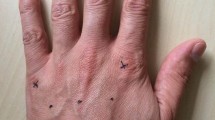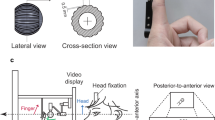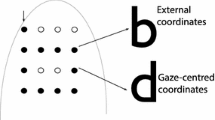Abstract.
We investigated the covert reflexive (exogenous) orienting of tactile spatial attention. Participants made speeded discrimination responses (up vs down) to a series of tactile targets presented randomly to the index finger or thumb of either hand. These targets were preceded at a variable stimulus onset asynchrony (200, 300, or 400 ms) by a spatially nonpredictive tactile cue (presented to both finger and thumb of one or other hand) on either the same or opposite side as the target. Tactile elevation discrimination responses were more rapid and accurate when the cue and target appeared on the same side than when they appeared on opposite sides. Our results provide the first direct empirical evidence that tactile spatial attention can be reflexively directed toward peripheral tactile cues leading to the facilitation of subsequent responses to stimuli presented at that body site.
Similar content being viewed by others
Author information
Authors and Affiliations
Additional information
Electronic Publication
Rights and permissions
About this article
Cite this article
Spence, C., McGlone, F.P. Reflexive spatial orienting of tactile attention. Exp Brain Res 141, 324–330 (2001). https://doi.org/10.1007/s002210100883
Received:
Accepted:
Issue Date:
DOI: https://doi.org/10.1007/s002210100883




